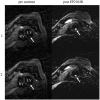Molecular MRI of Thrombosis
- PMID: 21253438
- PMCID: PMC3022329
- DOI: 10.1007/s12410-010-9061-5
Molecular MRI of Thrombosis
Abstract
This review focuses on recent approaches in using targeted MRI probes for noninvasive molecular imaging of thrombosis. Probe design strategies are discussed: choice of molecular target; nanoparticle versus small-molecule probe; and gadolinium versus iron oxide imaging reporter. Examples of these different design strategies are chosen from the recent literature. Novel contrast agents used to image direct and indirect binding to fibrin have been described as well as direct binding to activated platelets. Emphasis is placed on probes where utility has been demonstrated in animal models or in human clinical trials.
Figures





Similar articles
-
Peptide-based fibrin-targeting probes for thrombus imaging.Dalton Trans. 2017 Oct 31;46(42):14488-14508. doi: 10.1039/c7dt02634j. Dalton Trans. 2017. PMID: 29051933 Free PMC article. Review.
-
Eu-chelate anti-fibrin antibody-conjugated perfluorocarbon nanoparticles.2008 Jan 17 [updated 2008 Feb 20]. In: Molecular Imaging and Contrast Agent Database (MICAD) [Internet]. Bethesda (MD): National Center for Biotechnology Information (US); 2004–2013. 2008 Jan 17 [updated 2008 Feb 20]. In: Molecular Imaging and Contrast Agent Database (MICAD) [Internet]. Bethesda (MD): National Center for Biotechnology Information (US); 2004–2013. PMID: 20641487 Free Books & Documents. Review.
-
Development and in vitro study of a bi-specific magnetic resonance imaging molecular probe for hepatocellular carcinoma.World J Gastroenterol. 2019 Jun 28;25(24):3030-3043. doi: 10.3748/wjg.v25.i24.3030. World J Gastroenterol. 2019. PMID: 31293339 Free PMC article.
-
Targeted Molecular Iron Oxide Contrast Agents for Imaging Atherosclerotic Plaque.Nanotheranostics. 2020 May 30;4(4):184-194. doi: 10.7150/ntno.44712. eCollection 2020. Nanotheranostics. 2020. PMID: 32637296 Free PMC article.
-
Targeted probes for cardiovascular MRI.Future Med Chem. 2010 Mar;2(3):451-70. doi: 10.4155/FMC.09.154. Future Med Chem. 2010. PMID: 20539821 Free PMC article. Review.
Cited by
-
Preparation and characterization of gadolinium-loaded PLGA particles surface modified with RGDS for the detection of thrombus.Int J Nanomedicine. 2013;8:3745-56. doi: 10.2147/IJN.S49835. Epub 2013 Oct 1. Int J Nanomedicine. 2013. PMID: 24124363 Free PMC article.
-
Contrast-enhanced imaging of SPIO-labeled platelets using magnetomotive ultrasound.Phys Med Biol. 2013 Oct 21;58(20):7277-90. doi: 10.1088/0031-9155/58/20/7277. Epub 2013 Sep 27. Phys Med Biol. 2013. PMID: 24077004 Free PMC article.
-
Diagnostic Accuracy of High-Resolution Black-Blood MRI in the Evaluation of Intracranial Large-Vessel Arterial Occlusions.AJNR Am J Neuroradiol. 2019 Jun;40(6):954-959. doi: 10.3174/ajnr.A6065. Epub 2019 May 9. AJNR Am J Neuroradiol. 2019. PMID: 31072969 Free PMC article.
-
Thrombus Imaging Using 3D Printed Middle Cerebral Artery Model and Preclinical Imaging Techniques: Application to Thrombus Targeting and Thrombolytic Studies.Pharmaceutics. 2020 Dec 12;12(12):1207. doi: 10.3390/pharmaceutics12121207. Pharmaceutics. 2020. PMID: 33322710 Free PMC article.
-
Multisite Thrombus Imaging and Fibrin Content Estimation With a Single Whole-Body PET Scan in Rats.Arterioscler Thromb Vasc Biol. 2015 Oct;35(10):2114-21. doi: 10.1161/ATVBAHA.115.306055. Epub 2015 Aug 13. Arterioscler Thromb Vasc Biol. 2015. PMID: 26272938 Free PMC article.
References
-
- White RH. The epidemiology of venous thromboembolism. Circulation. 2003;107:I4–I8. - PubMed
-
- Guercini F, Acciarresi M, Agnelli G, et al. Cryptogenic stroke: Time to determine aetiology. J Thromb Haemost. 2008;6:549–554. - PubMed
-
- Mazighi M, Labreuche J, Gongora-Rivera F, et al. Autopsy prevalence of intracranial atherosclerosis in patients with fatal stroke. Stroke. 2008;39:1142–1147. - PubMed
-
- Mazighi M, Labreuche J, Gongora-Rivera F, et al. Autopsy prevalence of proximal extracranial atherosclerosis in patients with fatal stroke. Stroke. 2009;40:713–718. - PubMed
Grants and funding
LinkOut - more resources
Full Text Sources
Other Literature Sources
